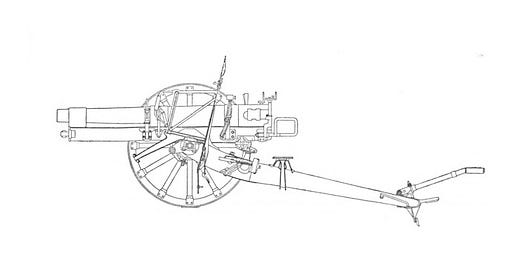In 1914, the German Field Artillery provided each active infantry division with a field artillery brigade. This brigade consisted of two field artillery regiments, each of which was made up of a pair of battalions (Abteilungen.) Each battalion, in turn, consisted of three batteries, each of which operated six field pieces.
Within each field artillery brigade, three of the battalions were armed with 77mm light field guns and one was equipped with light field howitzers. Thus each active infantry division disposed of 72 field pieces, 54 of which were guns and 18 of which were howitzers.
Reserve infantry divisions received much less in the way of field artillery than their active counterparts. In three cases - those of reserve formations formed by the armies of the kingdoms of Saxony and Württemberg - the single field artillery regiment assigned to a reserve infantry division consisted of two battalions of light field guns and one battalion of howitzers. The other Reserve infantry divisions formed upon mobilization for duty with armies in the field made do with two battalions of light field guns and no howitzers at all.
Ersatz infantry divisions, which were formed from men and equipment remaining at regimental depots after the Reserve infantry divisions had been formed, received four battalions of field guns. However, as each battalion consisted of two (rather than three) batteries, each division of that type possessed but eight field batteries.
The field artillery establishments of Reserve infantry divisions assigned to fortresses were organized in the same way as those of Ersatz infantry divisions. Such formations, however, were also supplied with a number of mobile Fußartillerie batteries.






